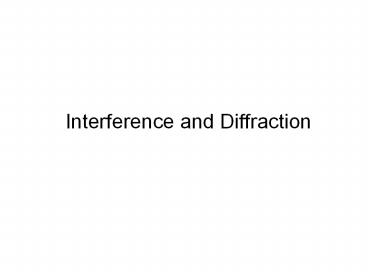Interference and Diffraction - PowerPoint PPT Presentation
1 / 32
Title: Interference and Diffraction
1
Interference and Diffraction
2
Diffraction of Light
Diffraction is the ability of light waves to bend
around obstacles placed in their path.
Water waves easily bend around obstacles, but
light waves also bend, as evidenced by the lack
of a sharp shadow on the wall.
3
Water Waves
A wave generator sends periodic water waves into
a barrier with a small gap, as shown below.
A new set of waves is observed emerging from the
gap to the wall.
4
Interference of Water Waves
An interference pattern is set up by water waves
leaving two slits at the same instant.
5
Youngs Experiment
In Youngs experiment, light from a monochromatic
source falls on two slits, setting up an
interference pattern analogous to that with water
waves.
6
The Superposition Principle
- The resultant displacement of two simul-taneous
waves (blue and green) is the algebraic sum of
the two displacements.
- The composite wave is shown in yellow.
Constructive Interference
Destructive Interference
The superposition of two coherent light waves
results in light and dark fringes on a screen.
7
Youngs Interference Pattern
Bright fringe
Dark fringe
Bright fringe
8
Conditions for Bright Fringes
Bright fringes occur when the difference in path
Dp is an integral multiple of one wave length l.
9
Conditions for Dark Fringes
Dark fringes occur when the difference in path Dp
is an odd multiple of one-half of a wave length
l/2.
10
Analytical Methods for Fringes
11
Analytical Methods (Cont.)
So that . . .
12
Example 1 Two slits are 0.08 mm apart, and the
screen is 2 m away. How far is the third dark
fringe located from the central maximum if light
of wavelength 600 nm is used?
x 2 m d 0.08 mm
l 600 nm y ?
d sin q 5(l/2)
The third dark fringe occurs when n 5
13
Example 1 (Cont.) Two slits are 0.08 mm apart,
and the screen is 2 m away. How far is the third
dark fringe located from the central maximum if l
600 nm?
y 3.75 cm
14
The Diffraction Grating
A diffraction grating consists of thousands of
parallel slits etched on glass so that brighter
and sharper patterns can be observed than with
Youngs experiment. Equation is similar.
15
The Grating Equation
16
Example 2 Light (600 nm) strikes a grating ruled
with 300 lines/mm. What is the angular deviation
of the 2nd order bright fringe?
To find slit separation, we take reciprocal of
300 lines/mm
Lines/mm ? mm/line
17
Example (Cont.) 2 A grating is ruled with 300
lines/mm. What is the angular deviation of the
2nd order bright fringe?
Angular deviation of second order fringe is
q2 21.10
18
A compact disk acts as a diffraction grating. The
colors and intensity of the reflected light
depend on the orientation of the disc relative to
the eye.
19
Interference From Single Slit
When monochromatic light strikes a single slit,
diffraction from the edges produces an
interference pattern as illustrated.
The interference results from the fact that not
all paths of light travel the same distance
some arrive out of phase.
20
Single Slit Interference Pattern
Each point inside slit acts as a source.
For rays 1 and 3 and for 2 and 4
First dark fringe
For every ray there is another ray that differs
by this path and therefore interferes
destructively.
21
Single Slit Interference Pattern
First dark fringe
Other dark fringes occur for integral multiples
of this fraction l/a.
22
Example 3 Monochromatic light shines on a single
slit of width 0.45 mm. On a screen 1.5 m away,
the first dark fringe is displaced 2 mm from the
central maximum. What is the wavelength of the
light?
l 600 nm
23
Diffraction for a Circular Opening
The diffraction of light passing through a
circular opening produces circular interference
fringes that often blur images. For optical
instruments, the problem increases with larger
diameters D.
24
Resolution of Images
Consider light through a pinhole. As two objects
get closer the interference fringes overlap,
making it difficult to distinguish separate
images.
25
Resolution Limit
Images are just resolved when central maximum of
one pattern coincides with first dark fringe of
the other pattern.
26
Resolving Power of Instruments
The resolving power of an instrument is a measure
of its ability to produce well-defined separate
images.
For small angles, sin q ? q, and the limiting
angle of resolution for a circular opening is
Limiting angle of resolution
27
Resolution and Distance
28
Example 4 The tail lights (l 632 nm) of an
auto are 1.2 m apart and the pupil of the eye is
around 2 mm in diameter. How far away can the
tail lights be resolved as separate images?
p 3.11 km
29
Summary
30
Summary (Cont.)
31
Summary (Cont.)
Interference from a single slit of width a
32
Summary (cont.)
The resolving power of instruments.































